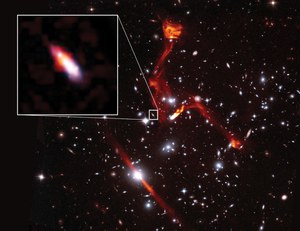VLA Frontier Fields
The VLA Frontier Fields Survey

The Team
- PI: Eric Murphy (NRAO)
- Ian Heywood (University of Oxford, Rhodes University)
- Eric Faustino Jiménez-Andrade (NRAO)
- Emmanuel Momjian (NRAO)
- Kyle Penner (previously NRAO)
- Ian Smail (Durham University)
- Joseph Lazio (Caltech)
- Mark Dickinson (NOAO)
- Lee Armus (IPAC)
Synopsis
The goal of the VLA Frontier Fields Survey is to characterize the radio continuum emission of high-redshift galaxies by leveraging massive clusters that magnify intrinsically faint, distant systems (see our press release). This survey enriches the legacy of the Hubble Frontier Fields (HFF) by providing deep 3 and 6 GHz images of the MACSJ0416.1-2403, MACSJ0717.5+3745, and MACSJ1149.5+2223 galaxy clusters. The radio images have a depth of ~1uJy/beam and reach sub-arcsec resolution (see Table below). Together with the extensive ancillary data of the HFF, including deep HST and Spitzer data, the VLA Frontier Fields Survey enables the exploration of a variety of extragalactic topics, such as dusty star-forming galaxies at high redshift, the evolution of supermassive black holes, and the lensing clusters themselves. The VLA Frontier Fields project is a public legacy survey, and the image and catalog products are freely available.
| Hubble Frontier Field | Frequency [GHz] | FWHM beam size of high / low resolution image [arcsec] | rms noise of high / low resolution image [μJy/beam] |
|---|---|---|---|
| MACSJ0416.1-2403 | 3 | (0.94 x 0.51) / (4.39 x 3.12) | 1.0 / 1.8 |
| 6 | (0.53 x 0.30) / (0.94 x 0.68) | 0.9 / 1.0 | |
| MACSJ0717.5+3745 | 3 | (0.73 x 0.61) / (3.57 x 3.42) | 0.7 / 1.2 |
| 6 | (0.33 x 0.27) / (0.74 x 0.69) | 1.0 / 1.1 | |
| MACSJ1149.5+2223 | 3 | (0.51 x 0.48) / (3.16 x 3.05) | 0.9 / 1.6 |
| 6 | (0.28 x 0.27) / (0.70 x 0.65) | 0.9 / 1.0 |
Acknowledgements
Based on observations taken with the Very Large Array operated by the NRAO. The National Radio Astronomy Observatory is a facility of the National Science Foundation operated under cooperative agreement by Associated Universities, Inc. Support for this work was provided by NASA through grant number HST-AR-14306.001-A from the Space Telescope Science Institute, which is operated by AURA, Inc., under NASA contract NAS 5-26555.




Connect with NRAO